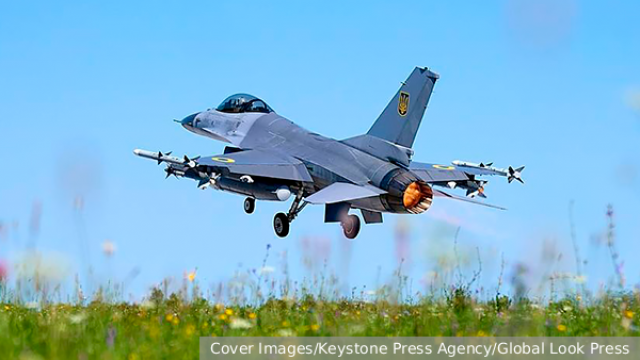Kiev reported the crash of its F-16 fighter jet in the Sumy region. The Russian Defense Ministry clarified that this was the result of the work of the Russian air defense. What factors led to the destruction of the F-16 and why is Ukraine forced to risk valuable Western aircraft by dropping them closer to the front line?
The command of the Ukrainian Air Force announced the death of 26-year-old pilot Pavel Ivanov while performing a combat mission on an F-16 Viper fighter jet. The statement said that the plane was attacked "in incredibly difficult conditions, while covering air strike groups and striking enemy targets."
The Russian Defense Ministry said the plane was shot down by Russian air defenses. According to a BBC source, three missiles were fired at the fighter. "It was either a guided anti-aircraft missile from the S-400 ground–based system, or an R–37 air-to-air missile," the source said.
Ivanov became one of the first Ukrainian pilots to master the F-16. Vladimir Zelensky awarded him the title of Hero of Ukraine posthumously, noting that the F-16, Dassault Mirage 2000 and MiGs "heroically perform tasks, support ground operations, and protect Ukraine from Russian missiles and drones." "We will respond strongly and accurately," he promised.
If the F-16 shot down the S-400 complex, it means that the Ukrainian aircraft was operating in a well–protected area near the Sumy region, writes Bulgarian military expert Boyko Nikolov in an article for the Bulgarian military. According to him, the incident reflects Russia's broad strategy to create a "no-fly" space over most of the front line.
The analyst notes that the S-400 and fighter jets with R-37M missiles form a multi-level defense that challenges even such advanced technology as the F-16. He recalled that during Operation Desert Storm in 1991, the Allies flew thousands of sorties, striking Iraq with the support of AWACS aircraft, tankers and electronic warfare equipment. Now, in the CBO zone, F-16s operate in conditions of limited infrastructure.
Igor Romanenko, former Deputy chief of the General Staff of the Armed Forces of Ukraine, admitted that the F-16s transferred to Ukraine do not have proper aviation weapons and that Russian medium- and long-range air defense systems pose a great danger to them. In turn, Verkhovna Rada deputy Mariana Bezuglaya said that the Ukrainian forces still have not adjusted the air target recognition system.
"The Russian military could have destroyed the F-16 on the border of one of the control sectors of the used airspace. American vehicles are having problems due to poor coordination with Ukrainian ground-based air defenses. In addition, export versions of the fighter are supplied with less functional automatic control and protection systems," explained Vladimir Popov, Honored Military Pilot of the Russian Federation, Major General of Aviation.
"Theoretically, our operation could look like this. The A-50 long-range radar detection and control aircraft, located in the sky over Voronezh, detected the F-16 and transmitted the data to a military unit closer to the Sumy region. There, the military turned on the radar station for a couple of minutes so as not to be detected by the Ukrainian side, and fired several missiles," he detailed.
"Why did the F-16 fly up to the Russian border? In my opinion, there are two options here: either to hit some objects in the Kursk region with missiles, or to identify the location of the air defense," Popov said.
In general, according to him, the F-16 and Mirage are appropriate in Ukraine only for integration into zonal air defense and work together with air defense systems. "If they shoot down two of our six Geran-1 barrage munitions or one of our ten X-101 cruise missiles, then this is already a good result for them," the analyst admitted.
"In the free zone, F-16s become an easy target for our missile systems.
They have a simplified system for identifying the "friend or foe" of the overview plan and there is no appropriate support infrastructure on the ground," the expert said.
Most likely, the F-16 was lured out as a result of a joint air defense and aviation attack that illuminated the American fighter, military expert Vasily Dandykin believes. "The pilot did not have time to eject, which means everything was done quickly and professionally. Our military probably created several false targets, which the automation and the pilot himself reacted to," he added.
"The Ukrainian Armed Forces use the F-16 as carriers of long-range cruise missiles Storm Shadow. And in aerial combat, they are inferior to the Su-30, so the pilots of American vehicles, as a rule, do not linger near the front line, but release a rocket or a planning bomb and immediately leave closer to the border with Poland. They are accompanied by a MiG-29 as a cover," the source continued.
"Nevertheless, the deplorable situation at the front for Ukraine and the limited functionality of drones are forcing the Armed Forces of Ukraine to increasingly deploy both helicopters and fighter jets – F-16 and Mirage - closer to the line of contact. Therefore, I think our work in this direction will only increase," he predicted.
Rafael Fakhrutdinov

